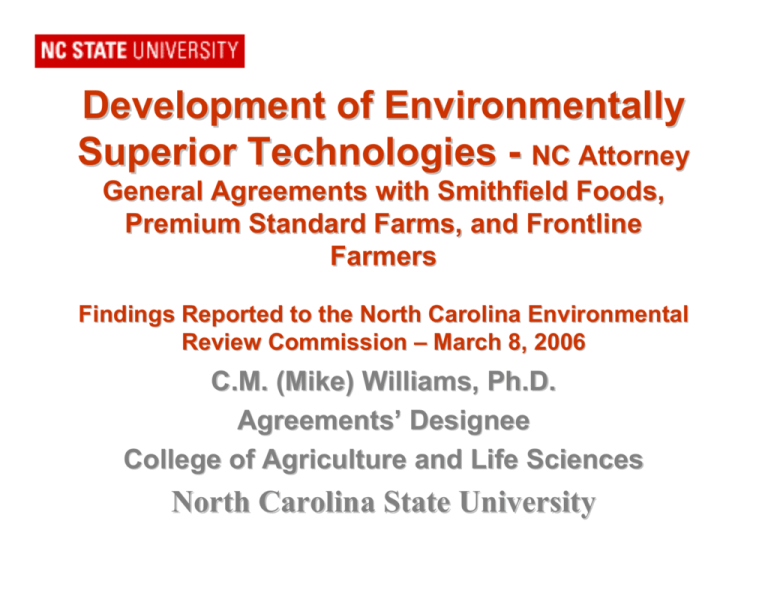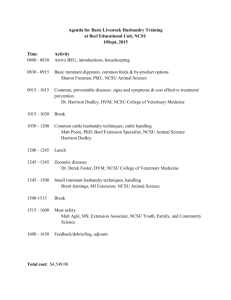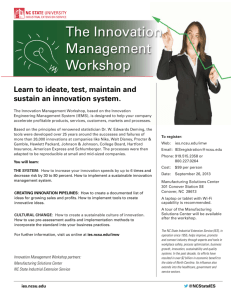Development of Environmentally Superior Technologies
advertisement

Development of Environmentally Superior Technologies - NC Attorney General Agreements with Smithfield Foods, Premium Standard Farms, and Frontline Farmers Findings Reported to the North Carolina Environmental Review Commission – March 8, 2006 C.M. (Mike) Williams, Ph.D. Agreements’ Designee College of Agriculture and Life Sciences North Carolina State University Agreements - Background • Smithfield Foods (July 2000) - $15 million for development of “Environmentally Superior Technologies” (EST); $50 million for “environmental enhancement” activities • Premium Standard Farms (September 2000) – $2.5 million ($2.3 for EST) • Frontline Farmers (March 2002) - “use its best efforts and influence to encourage its members to convert to economically feasible EST” • Agreements’ “Designee” responsible for “Technology Determinations” – a written determination re findings relative to EST Phase 1 Technology Determination Rpt. issued July 2004 (8 technologies covered); also included quantification of environmental standards “ORBIT” HSAD “Barham Farm” “EKOKAN” “BEST” “RECIP” “Super Soils” Generation 1 Belt System 1 Belt System 2 Phase 1 (July 2004) Technology Determination findings: 2 Contingent EST “Super Soils” Generation 1 “ORBIT” HSAD Contingencies • Economics • Environmental performance re 2nd generations and steady state operations Phase 2 Technology Determination Report July 2005 (7 technologies covered) “ANT” SBR “Super Soils” solids compost Gasification of solids Constructed Wetlands Insect biomass from solids “BEST” fluidized bed combustion of solids “ISSUES” aerobic blanket “ISSUES” permeable cover “ISSUES” mesophilic digester Phase 2 Technology Determination Report also included costs-returns data for original 8 technologies and industry impact economic report “ORBIT” “Barham Farm” HSAD “EKOKAN” “BEST” “RECIP” “Super Soils” Generation 1 Belt System 1 Belt System 2 Phase 2 Technology Determination findings: 3 additional contingent EST “Super Soils” solids compost Contingencies Gasification of solids “BEST” fluidized bed combustion of solids • Economics • Permits March 8, 2006 Phase 3 Technology Determination Report includes detail findings for 2 additional technologies and overview of all technologies and findings relative to EST standards. “AgriClean” “Environmental Technologies” Environmentally Superior Technologies defined: • “permittable by the appropriate governmental authority • determined to be technically, operationally, and economically feasible for identified categories of farms • meets the following performance standards…” Performance Standards (Ref: General Assembly of North Carolina, Session 1997, Session Law 1998-188, House Bill 1480) • “Eliminate the discharge of animal waste to surface waters and groundwater through direct discharge, seepage, or runoff; • Substantially eliminate atmospheric emissions of ammonia; • Substantially eliminate the emission of odor that is detectable beyond the boundaries of the parcel of land on which the swine farm is located; • Substantially eliminate the release of diseasetransmitting vectors and airborne pathogens; • Substantially eliminate nutrient and heavy metal contamination of soil and groundwater” Economic Feasibility Determination • Projected 10 year annualized cost of the technology (including capital, operation and maintenance) per 1000 # steady state live weight for each category of farm system • Compared to lagoon and spray-field system • Projected revenues, including income from byproducts • Available cost-share monies or other financial assistance from federal, state or other public sources • Impact that the adoption of the technology may have on the competitiveness of the NC pork industry • ID/quantification (if possible) of emissions to environmental media from each category of farm system implementing the technology as compared to lagoon and spray-field system • Estimate of the economic benefits to NC households arising from the changes in emissions to environmental media resulting from implementation of the technology (not mandated in Agreements) Advisory Panel Representation • • • • • Government Environmental interests Community Interests Companies Individuals with expertise in: animal waste management; environmental science and public health; economics; and business management Advisory Panel Membership • • • • • • • • • • • • • Katy Ansardi; Sustainable NC Don Butler; Murphy-Brown, LLC Kim Colson; NCDENR Bundy Lane; Frontline Farmers, Inc. Steven Leath; NCSU, NC Agricultural Research Service George Lucier; National Institute of Environ. Health Sciences Randy Mapes; AgProVision, LLC Michelle Nowlin: Southern Environ. Law Center Fred Pfaender; UNC-CH, Dept. of Environ. Science and Engineering Karen Priest; Alliance for a Responsible Swine Industry Joe Rudek; NC Environ. Defense Paul Sherman; NCDENR Shihwu Sung; ISU, Dept. of Civil and Construction Engineering • • • • • • • • • • John Sweeten; Texas A&M Univ.,Texas Agri. Experiment Station Dave Townsend; Premium Standard Farms, Inc. Phil Westerman; NCSU, Dept. of Biol. and Agri. Engineering Richard Whisnant; UNC-CH, School of Gov., Environ. Finance Center Chantal Line Carpentier; Comm. for Environ. Cooperation Richard Eason; Cape Fear Farm Credit Bart Ellis; Smithfield Foods, Inc. Bruce Gardner; Univ. MD, College Agriculture and Natural Resources Arturo Rios; US EPA Kerry Smith; NCSU, Dept. of Agri. and Resources Economics Agreements’ Project Locations in NC Smithfield bio fuel from manure project in Utah and PSF Crystal Peak Farms fertilizer from manure project in Missouri. NC EST models proposed. Project Principal Investigators • • • • • • • • • • • • • • • • • • • • • • • • Viney Aneja, NCSU MEAS Pal Arya, NCSU MEAS Adrian Atkinson, NCSU ARE Craig Baird, NCSU BAE Bert Bock, TVA Len Bull, NCSU APWMC Preston Burnette, NCSU ANS Gary Burtle, Univ. GA Jay Cheng, NCSU BAE Jan Chvosta, NCSU ARE John Classen, NCSU BAE Kurt Creamer, NCSU APWMC Dave Dickey, NCSU STAT Robert Dove, Univ. GA Aprel Ellison, USDA-ARS Brevick Graham, Duke Med Center Frank Humenik, NCSU BAE Pat Hunt, USDA-ARS Deug-Soo Kim, NCSU MEAS Jeanne Koger, NCSU ANS Sarah Liehr, NCSU BAE Christina Likirdopulos, UNC-CH ESE Michele Marra, NCSU ARE Patricia Millner, USDA-ARS • • • • • • • • • • • • • • • • • • • • • • • • Kathleen Mottus, UNC- CH ESE Briam Murray, RTI Larry Newton, Univ. GA Shabnam Qureshi, UNC-CH ESE Mary Peet, NCSU HS Mark Rice, NCSU BAE Mitch Renkow, NCSU ARE Wayne Robarge, NCSU Soil Sci. Ian Rumsey, NCSU MEAS Susan Schiffman, Duke Med Center Craig Sheppard, Univ. GA Chip Simmons, UNC-CH ESE Mark Sobsey, UNC-CH ESE Len Stefanski, NCSU STAT Ariel Szogi, USDFA ARS Lori Todd, UNC-CH ESE Theo VanKempen, NCSU ANS Matias Vanotti, USDA-ARS Wes Watson, NCSU ENT Phil Westerman, NCSU BAE Lynn Worley-Davis, NCSU APWMC Michael Wohlgenant, NCSU ARE Ada Wossink, NCSU ARE Kelly Zering, NCSU ARE Technology Determination: data requirements Performance Data • Project PI report • OPEN team report • ECON team report Project PI report focus is on treatment system unit components • Partitioning and fate (conversion or removal) of: solids, organics, N, P, Cu, Zn • Operational feasibility (problems encountered, trained operator requirement, frequency and duration of operator on site, etc.) OPEN team report focus is on emissions of: • odor • pathogens • ammonia ECON team report focus is on technology unit costs/returns and industry impact Technology Determination: process 1. Draft reports from Project Investigators, OPEN, ECON teams 2. Draft review by panel and technology supplier 3. Investigators consider review input and finalize reports 4. Panel review / discussion 5. Designee prepares Technology Determination Draft 6. Panel review / discussion 7. Technology Determination Final Reports (Phase 1, 2, 3) Performance Standards (Ref: General Assembly of North Carolina, Session 1997, Session Law 1998-188, House Bill 1480) • “Eliminate the discharge of animal waste to surface waters and groundwater through direct discharge, seepage, or runoff; • Substantially eliminate atmospheric emissions of ammonia; • Substantially eliminate the emission of odor that is detectable beyond the boundaries of the parcel of land on which the swine farm is located; • Substantially eliminate the release of diseasetransmitting vectors and airborne pathogens; • Substantially eliminate nutrient and heavy metal contamination of soil and groundwater” Advisory Panel Membership • • • • • • • • • • • • Katy Ansardi; Sustainable NC Don Butler; Murphy-Brown, LLC Kim Colson; NCDENR Bundy Lane; Frontline Farmers, Inc. Steven Leath; NCSU, NC Agricultural Research Service George Lucier; National Institute of Environ. Health Sciences Randy Mapes; AgProVision, LLC Michelle Nowlin: Southern Environ. Law Center Fred Pfaender; UNC-CH, Dept. of Environ. Science and Engineering Karen Priest; Alliance for a Responsible Swine Industry Joe Rudek; NC Environ. Defense Paul Sherman; NCDENR Engineering Subcommittee Chair: Paul Sherman • • • • • • • • • • • Shihwu Sung; ISU, Dept. of Civil and Construction Engineering John Sweeten; Texas A&M Univ.,Texas Agri. Experiment Station Dave Townsend; Premium Standard Farms, Inc. Phil Westerman; NCSU, Dept. of Biol. and Agri. Engineering Richard Whisnant; UNC-CH, School of Gov., Environ. Finance Center Chantal Line Carpentier; Comm. for Environ. Cooperation Richard Eason; Cape Fear Farm Credit Bart Ellis; Smithfield Foods, Inc. Bruce Gardner; Univ. MD, College Agriculture and Natural Resources Arturo Rios; US EPA Kerry Smith; NCSU, Dept. of Agri. and Resources Economics Eliminate the discharge of animal waste to surface waters and groundwater through direct discharge, seepage, or runoff. All wastewater-holding structures must have a mechanism for containing the flow rate of the largest pump in the system for the maximum amount of time that an operator will not be on-site. Technologies should contain less than the volume equivalent of one month of flow in concentrated waste prior to complete treatment. Any earthen structures should be designed and constructed to current Natural Resource Conservation Service (NRCS) standards and have a maximum hydraulic conductivity of 1.25 x 10-6 cm/sec. Structures, other than earthen, should be designed and constructed using proper engineering practices to eliminate seepage. Solids storage structures should meet current NRCS design standards. Land application of treated wastewater or solids should be based on realistic crop yield expectations, land application setbacks, buffers, and hydraulic loading rates that at a minimum maintain compliance with current NRCS, Local, State, and Federal standards and/or requirements. Substantially eliminate atmospheric emissions of ammonia. Approximately 80% reduction, as compared to a typical swine farm, of ammonia emissions from waste storage/treatment components and land application areas. System must also target reduction of ammonia from the barns. Substantially eliminate the emission of odor that is detectable beyond the boundaries of the parcel or tract of land on which the swine farm is located. Odor intensity levels, measured using an index scale from 0-8, should not exceed the established metric of 2 (or equivalent) at a property line on which the swine farm is located. Eulerian- Lagrangian model to simulate odor dispersion y = 33.546 ex x = odor intensity (0-8) Substantially eliminate the release of disease-transmitting vectors and airborne pathogens. Approximately 4 log reductions of pathogens (microorganisms documented to be of human health concern) in the treated liquid and solid waste stream, as compared to concentrations of the pathogens in raw manure. All components of the waste management system (technology treatment, fate of farm generated solids, method and location of land application of liquid and/or solids, etc.) are considered factors for pathogen reductions. Pathogens and Indicators Measured on Candidate EST and Conventional Farm Sites Air Samples Waste Stream (liquid/solids) and Environmental Samples • • • • • Fecal Coliform bacteria E. coli Enterococci Total coliphage (viruses) Clostridium perfringens spores • Salmonella • • • • Fecal Coliform bacteria E. coli Total coliphage (viruses) Clostridium perfringens spores • Salmonella • Total aerobic bacteria • Total fungi •* contracted Bacterial endotoxins to Peter Thorne, University of Iowa Substantially eliminate nutrient and heavy metal contamination of soil and groundwater. System should reduce total nitrogen mass by 75% and total phosphorus, copper and zinc mass by 50% from influent levels for the whole farm. Current NC NRCS Nutrient Management Standard 590 must be met, including added considerations of current realistic yield expectations, individual plant available nitrogen calculations, NC Phosphorus Loss Assessment Tool (PLAT) evaluation to determine phosphorus loss and application rates, and metal soil index threshold warnings. Where on-farm resources (i.e. available land) are not sufficient to meet these described standards, reductions may be met by transporting the nutrients off the farm, and/or animal diet modification. Economic feasibility determination Unit cost = $/1000 lbs. SSLW/yr/annualized for 10 yrs 1st generation measured costs-returns ~ $400 2nd generation proposed at app. ¼ 1st generation costs July 3, 2002 Economic feasibility determination Unit cost = $/1000 lbs. SSLW/yr/annualized for 10 yrs Projected app. $87 unit cost (2004) “Super Soils”: Finishing operation, 4,000 head, 6 houses, 10,000 gal/d waste stream flow. 1st generation data Parameter Environmental data values COD 97% reduction Solids 98-99% reduction Ammonia 99% reduction Phosphorus 95% reduction Pathogens 1.4-4.4 Log10 reductions Odor – 200m from source 2.1 of 8 intensity (8=max) Odor – 400m from source 1.3 of 8 intensity (8=max) Economic Feasibility Determination • Projected 10 year annualized cost of the technology (including capital, operation and maintenance) per 1000 # steady state live weight for each category of farm system • Compared to lagoon and spray-field system • Projected revenues, including income from byproducts • Available cost-share monies or other financial assistance from federal, state or other public sources • Impact that the adoption of the technology may have on the competitiveness of the NC pork industry Economic Feasibility Analysis STAGE I STAGE II DATA COLLECTION FOR TECHNOLOGIES AND BASELINE COST MODELING Detail Technology Descriptions Technology Design Equations Experiment Invoices Operating Cost and Return Data Adjusted Standardized Prices, Flows and Concentrations Performance Data Component Prices Design Parameters And Assumptions -Experiments -Literature -Industry Experts By-Product Prices STAGE III PREDICTED COST Incremental Cost and Return Calculations For Size-Type Categories Input to Task 2 (Industry Impact) Technology Baseline (lagoon and sprayfield) On-Farm Complete Systems AgriClean Annualized Cost1 ($ / 1,000 lbs. SSLW / year) $86.81 Annualized Incremental Cost1 ($ /1,000 lbs. SSLW / year) Insufficient data ANT Sequencing Batch Reactor (SBR) $221.43 Barham Farm $89.17 Belt System $89.39 BEST (FAN + TFS) $114.56 BEST (Filtramat + TFS) $146.50 Constructed Wetlands $168.05 EKOKAN $342.26 Environmental Technologies (Sustainable NCFrontline Farmers) $136.70 ISSUES Aerobic Blanket System (ABS) $103.26 ISSUES Permeable Cover System (PCS) $122.71 ISSUES RENEW $125.79 Re-Cip $143.21 Super Soils $399.71 Separated Solids Treatment Systems (Add-On Technologies)2, 3 (assumes 0.43 dry tons of solids collected / 1,000 lbs. SSLW / year) Annualized Incremental Cost1 ($ / 1,000 lbs. SSLW / year) BEST Idaho (centralized fluidized bed combustion facility) $255.68 Gasifier (RE-Cycle) $76.33 High Solids Anaerobic Digester (ORBIT) $373.22 Insect Biomass from Solids (black soldier fly) Super Soils Composting Facility Insufficient data $83.27 Industry impacts: Econ investigator’s assessment Incremental Cost2 $ /1,000 pounds SSLW / year Predicted Short Run Reduction Predicted Intermediate Run Reduction Predicted Long Run Reduction % reduction in North Carolina market quantities (1,000 pounds of weight marketed per year) Predicted Annual Cost Incurred by Remaining Producers3 $ / year $440.89 15.5% 49.1% 62.7% $384,662,000 $396.80 14.0% 44.2% 56.4% $366,763,000 $352.71 12.4% 39.3% 50.2% $345,338,000 $308.62 10.9% 34.4% 43.9% $319,953,000 $264.53 9.3% 29.5% 37.6% $290,743,000 $220.45 7.8% 24.6% 31.3% $256,475,000 $176.36 6.2% 19.7% 25.1% $215,841,000 $132.27 4.7% 14.7% 18.8% $170,141,000 $88.18 3.1% 9.8% 12.5% $118,936,000 $44.09 1.6% 4.9% 6.3% $62,224,000 Advisory Panel Membership • • • • • • • • • • • • Katy Ansardi; Sustainable NC Don Butler; Murphy-Brown, LLC Kim Colson; NCDENR Bundy Lane; Frontline Farmers, Inc. Steven Leath; NCSU, NC Agricultural Research Service George Lucier; National Institute of Environ. Health Sciences Randy Mapes; AgProVision, LLC Michelle Nowlin: Southern Environ. Law Center Fred Pfaender; UNC-CH, Dept. of Environ. Science and Engineering Karen Priest; Alliance for a Responsible Swine Industry Joe Rudek; NC Environ. Defense Paul Sherman; NCDENR Economics Subcommittee Chair: Richard Whisnant • • • • • • • • • • • Shihwu Sung; ISU, Dept. of Civil and Construction Engineering John Sweeten; Texas A&M Univ.,Texas Agri. Experiment Station Dave Townsend; Premium Standard Farms, Inc. Phil Westerman; NCSU, Dept. of Biol. and Agri. Engineering Richard Whisnant; UNC-CH, School of Gov., Environ. Finance Center Chantal Line Carpentier; Comm. for Environ. Cooperation Richard Eason; Cape Fear Farm Credit Bart Ellis; Smithfield Foods, Inc. Bruce Gardner; Univ. MD, College Agriculture and Natural Resources Arturo Rios; US EPA Kerry Smith; NCSU, Dept. of Agri. and Resources Economics Requests to Econ. Subcommittee • Consideration of information provided in the costs-returns and market impacts reports • Quantitative recommendations relative to mandated economic feasibility requirements • Assessment of how EST implementation schedule impacts “determination of economic feasibility’ Economics Subcommittee Consensus Findings • • • • • Designee should consider economic versus financial points of view regarding feasibility – e.g. in addition to the financial consequences which focus on payments made by farmers, the Agreements require attention to the true economic consequences, including non-monetized commitment of resources. The economic models used to determine the costs-returns and predicted impact on the competitiveness of the industry when utilizing the determined EST costs are well reasoned and well justified and thoroughly conducted but include uncertainty and many assumptions (the same conclusions were derived by external ad hoc reviewers). In consideration of who makes up the North Carolina pork industry, Designee should consider any and all business entities physically located in North Carolina that generate their income from either the production of live swine or the meat packing of pork. It is economically appropriate to implement EST in phases, allowing pilot testing and refinement of the technologies before they are adopted industry wide. New farm categories and company owned farms are appropriate and obvious candidates for this approach. The time frame for adoption of EST is important relative to the time value of money and assessing economic feasibility, e.g. additional time for implementation reduces the economic impacts on North Carolina swine herd size. Economics Subcommittee Non-Consensus Findings • Competitiveness does not mean maintaining the present North Carolina hog inventory size and does not mean avoiding any net increase in waste handling costs. Designee should consider that implementation of EST that has a predicted economic consequence of reducing the North Carolina swine herd by 12% economically feasible. This is, in part, justified based on precedent established by the North Carolina General Assembly upon adoption in 1993 of the so called “.0200 Rules”, which were predicted to result in 12% of the State’s swine operations not remaining in business. • Institutional considerations should be studied in consideration of EST implementation planning, e.g. an institution created to oversee technology transition, tradable permits, etc. would ensure that widespread conversion occurs in the most economically feasible manner possible. Economics Subcommittee Non-Consensus Findings • The Agreements did not seek to close farms or otherwise reduce herd size in North Carolina. • A hog production entity becomes non-competitive when its inability to fund production results in lost market share and an EST is economically feasible if and only if the commercial application of the technology in only North Carolina has no adverse affect, e.g. no net increase in cost or reduction in herd size, on the fiscal competitiveness of North Carolina operations as compared to pork operations in all other states. • Byproduct revenue from EST must exist to offset any higher operating and capital costs of the EST and the best opportunity for the candidate EST studied is fossil fuel substitutes. EST Economic Feasibility defined by Designee: A technology may be economically feasible even though it would impose incremental cost increases on the North Carolina swine industry and potentially result in a reduction in swine herd size in North Carolina. Technologies will be considered candidates for EST Determinations only if the maximum predicted reduction in herd size resulting from implementation would not exceed 12 percent. The Designee will be responsible for determining whether the predicted herd size reduction that would result from the implementation of a technology is sufficiently accurate to consider it a candidate for determination as an EST. The Designee will also be responsible for determining, and limiting his determination and implementation recommendations to a category, or categories of farms, to ensure that an EST Determination would not result in unintended negative impacts and consequences for other farms which are dependent on the EST farms for their ongoing supply of production animals. Phase 3 Technology Determination findings: 5 EST for new farm categories “Super Soils” Generation 1 “Super Soils” solids compost Gasification of solids “ORBIT” HSAD “BEST” fluidized bed combustion of solids Farm categories New farm category: farms using EST on sites that have not been used previously for the production of swine (“Greenfields”); construction of new swine facilities using the EST on farms which previously housed swine, but which are no longer permitted for that purpose; and expansions (for purposes of increasing permitted herd size) of existing swine farms using the EST to treat waste for new construction on such existing swine farms. In the case of expansions, this determination applies only to the waste generated from the expansion. Farm categories Existing farm categories: Contingent EST, as described in the July 2004 and 2005 technology determination reports, have not at the current time met economic feasibility conditions required for unconditional EST to be implemented onto existing farm categories in North Carolina. Technologies “on the bubble” of qualifying as EST “Environmental Technologies’ Barham Farm “ANT” SBR “RECIP” Industry impacts: alternative assessment by some members of Economics Subcommittee Incremental Cost Predicted Short Run Reduction Predicted Intermediat e Run Reduction Predicted Long Run Reduction $/1,000 pounds SSLW/year % reduction in North Carolina hog inventory (1,000 pounds SSLW) % reduction from current revenue $440.89 9.6 30.4 38.0 26 $396.80 8.6 27.3 34.5 23 $352.71 7.7 24.3 31.0 21 $308.62 6.7 21.3 27.1 18 $264.53 5.8 18.2 23.2 15 $220.45 4.8 15.2 19.4 12 $176.36 3.8 12.2 15.5 10 $132.27 2.9 9.1 11.6 7 $88.18 1.9 6.1 7.8 5 $44.09 1.0 3.0 3.9 2 Predicted Long Term Revenue Reduction Recommendations • Continue, as expeditiously as possible, current efforts by targeted technology suppliers and researchers to improve upon their treatment processes to reduce the costs of their respective treatment systems. • Establish a framework or process by which additional technologies may be considered viable Environmentally Superior Technologies. This would include technologies that can be improved upon (technically and / or operationally and / or economically) as a result of information derived from this initiative, as well as technologies that were not part of this funded initiative. • Identify potential institutional incentives, public policies, and markets related to the sale of byproducts (with priority on energy production) that will reward farmers for utilizing technologies identified by this process that are shown to yield improvements and environmental benefits over the current lagoon spray field system. The optimal method of achieving net cost reductions and even positive revenue flows from alternative technologies is to install targeted technologies on a sufficient number of farms to facilitate engineering improvements, value-added product market development, and other cost reduction methods. Summary 1. 5 Environmentally Superior Technologies identified that, 2. Meet environmental standards established by the state of North Carolina (and quantified through this process). 3. Economic feasibility has been defined. 4. Process for development and verification of EST documented. 5. Additional technologies have been verified that some modification are capable of meeting EST standards. 6. Process for implementation of EST proposed. www.cals.ncsu.edu/waste_mgt/ (All reports posted)






